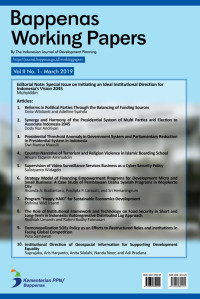Text
Institutional direction of geospacial information for supporting development equality
Spatial inequality occurs because the rate of availability of geospatial data has not been able to catch up and meet user needs. The root of the problem occurs because the network nodes in the area have not yet been formed or dissolved. The institutional status of network nodes at the provincial level as of October 2018, only 20 out of 34 provinces are operational, with 4 institutional options, namely UPT, Bappeda, Ad Hoc Regional Secretary and Ad Hoc Diskominfotik. This triggered anxiety for 14 regions that had not yet formed network nodes and 3 other UPTDs that were still awaiting evaluation results. To determine the institution of ideal geospatial information, BIG has conducted a study of institutional arrangements to realize effective and efficient regional apparatus organizations according to their duties and functions. The study with qualitative research methods was carried out by analyzing criteria and rating on institutional aspects in order to strengthen IDSN, based on applicable policies and laws as well as the results of the network node operationalization questionnaire in the province. Furthermore, the study was strengthened using quantitative research methods by comparing the costs and benefits of each institutional option (cost and benefit analysis) through the net present value approach. The results of the two methods are 2 alternative institutional geospatial information with the best value, namely Option 1 UPTB (Ideal for the long term) and Option 3 Ad Hoc in Regional Secretary (Quick Win for the medium term)
Ketersediaan
Tidak ada salinan data
Informasi Detail
- Judul Seri
-
Bappenas Working Papers
- No. Panggil
-
338.9 Bap
- Penerbit
- Jakarta : Kementrian PPN/ Bappenas., 2019
- Deskripsi Fisik
-
p. 133-157
- Bahasa
-
English
- ISBN/ISSN
-
2620-6013
- Klasifikasi
-
338.9
- Tipe Isi
-
text
- Tipe Media
-
-
- Tipe Pembawa
-
-
- Edisi
-
Vol. 2 No. 1 (2019)
- Subjek
- Info Detail Spesifik
-
-
- Pernyataan Tanggungjawab
-
-
Versi lain/terkait
Tidak tersedia versi lain
Lampiran Berkas
Komentar
Anda harus masuk sebelum memberikan komentar

 Karya Umum
Karya Umum  Filsafat
Filsafat  Agama
Agama  Ilmu-ilmu Sosial
Ilmu-ilmu Sosial  Bahasa
Bahasa  Ilmu-ilmu Murni
Ilmu-ilmu Murni  Ilmu-ilmu Terapan
Ilmu-ilmu Terapan  Kesenian, Hiburan, dan Olahraga
Kesenian, Hiburan, dan Olahraga  Kesusastraan
Kesusastraan  Geografi dan Sejarah
Geografi dan Sejarah